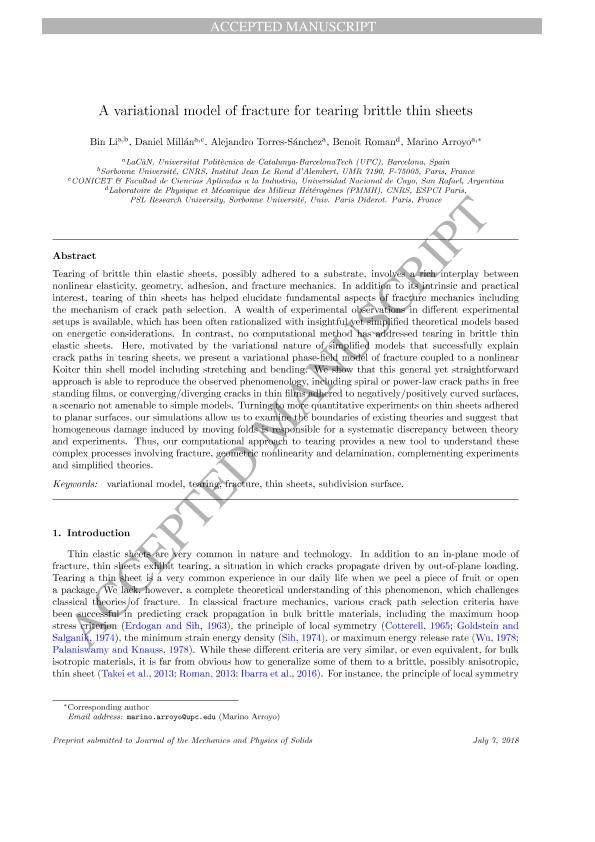Mostrar el registro sencillo del ítem
dc.contributor.author
Li, Bin
dc.contributor.author
Millán, Raúl Daniel

dc.contributor.author
Torres Sánchez, Alejandro
dc.contributor.author
Roman, Benoît
dc.contributor.author
Arroyo Balaguer, Marino

dc.date.available
2020-03-20T16:10:02Z
dc.date.issued
2018-10
dc.identifier.citation
Li, Bin; Millán, Raúl Daniel; Torres Sánchez, Alejandro; Roman, Benoît; Arroyo Balaguer, Marino; A variational model of fracture for tearing brittle thin sheets; Pergamon-Elsevier Science Ltd; Journal of the Mechanics and Physics of Solids; 119; 10-2018; 334-348
dc.identifier.issn
0022-5096
dc.identifier.uri
http://hdl.handle.net/11336/100401
dc.description.abstract
Tearing of brittle thin elastic sheets, possibly adhered to a substrate, involves a rich interplay between nonlinear elasticity, geometry, adhesion, and fracture mechanics. In addition to its intrinsic and practical interest, tearing of thin sheets has helped elucidate fundamental aspects of fracture mechanics including the mechanism of crack path selection. A wealth of experimental observations in different experimental setups is available, which has been often rationalized with insightful yet simplified theoretical models based on energetic considerations. In contrast, no computational method has addressed tearing in brittle thin elastic sheets. Here, motivated by the variational nature of simplified models that successfully explain crack paths in tearing sheets, we present a variational phase-field model of fracture coupled to a nonlinear Koiter thin shell model including stretching and bending. We show that this general yet straightforward approach is able to reproduce the observed phenomenology, including spiral or power-law crack paths in free standing films, or converging/diverging cracks in thin films adhered to negatively/positively curved surfaces, a scenario not amenable to simple models. Turning to more quantitative experiments on thin sheets adhered to planar surfaces, our simulations allow us to examine the boundaries of existing theories and suggest that homogeneous damage induced by moving folds is responsible for a systematic discrepancy between theory and experiments. Thus, our computational approach to tearing provides a new tool to understand these complex processes involving fracture, geometric nonlinearity and delamination, complementing experiments and simplified theories.
dc.format
application/pdf
dc.language.iso
eng
dc.publisher
Pergamon-Elsevier Science Ltd

dc.rights
info:eu-repo/semantics/openAccess
dc.rights.uri
https://creativecommons.org/licenses/by-nc-nd/2.5/ar/
dc.subject
VARIATIONAL MODEL
dc.subject
TEARING
dc.subject
FRACTURE
dc.subject
THIN SHEETS
dc.subject
SUBDIVISION SURFACES
dc.subject.classification
Matemática Aplicada

dc.subject.classification
Matemáticas

dc.subject.classification
CIENCIAS NATURALES Y EXACTAS

dc.title
A variational model of fracture for tearing brittle thin sheets
dc.type
info:eu-repo/semantics/article
dc.type
info:ar-repo/semantics/artículo
dc.type
info:eu-repo/semantics/publishedVersion
dc.date.updated
2020-03-20T13:11:15Z
dc.journal.volume
119
dc.journal.pagination
334-348
dc.journal.pais
Estados Unidos

dc.description.fil
Fil: Li, Bin. Universidad Politécnica de Catalunya; España. Sorbonne Université; Francia. Centre National de la Recherche Scientifique; Francia
dc.description.fil
Fil: Millán, Raúl Daniel. Universidad Nacional de Cuyo. Facultad de Ciencias Aplicadas a la Industria; Argentina. Consejo Nacional de Investigaciones Científicas y Técnicas. Centro Científico Tecnológico Conicet - Mendoza; Argentina. Universidad Politécnica de Catalunya; España
dc.description.fil
Fil: Torres Sánchez, Alejandro. Universidad Politécnica de Catalunya; España
dc.description.fil
Fil: Roman, Benoît. Centre National de la Recherche Scientifique; Francia. Sorbonne Université; Francia
dc.description.fil
Fil: Arroyo Balaguer, Marino. Universidad Politécnica de Catalunya; España
dc.journal.title
Journal of the Mechanics and Physics of Solids

dc.relation.alternativeid
info:eu-repo/semantics/altIdentifier/url/https://linkinghub.elsevier.com/retrieve/pii/S0022509618303156
dc.relation.alternativeid
info:eu-repo/semantics/altIdentifier/doi/http://dx.doi.org/10.1016/j.jmps.2018.06.022
Archivos asociados
